OWC’s Mercury Extreme Pro was one of our favorite SF-1200 SSDs at the time, and remains a solid performer today. But the new wave of SATA 6Gb/s has enthusiasts excited about taking SSD performance to the next level. The OWC Mercury Extreme Pro 6G does just that and more, leveraging the new SandForce SF-2281 processor to deliver sustained sequential reads of up to 559MB/s and writes up to 527MB/s.
OWC is second to market with a consumer-grade enthusiast SSD based on the scorching performance of the SandForce SF-2200 processor family, pacing behind OCZ and the Vertex 3 by just a few weeks. The comparisons between the two drives are natural and frankly, these two SSDs are in a class of their own. Both companies spend a great deal of time tweaking for performance and OWC is rightfully proud of their designed and assembled in America heritage.
Nothing else currently available comes close in terms of straight line speeds – so the showdown begins. While we wait for the rest of the SandForce licensees to figure out a plan to get to market, the Vertex 3 and Mercury Extreme Pro 6G get the advantage fighting to establish themselves as the go to SSD option for enthusiast computing.
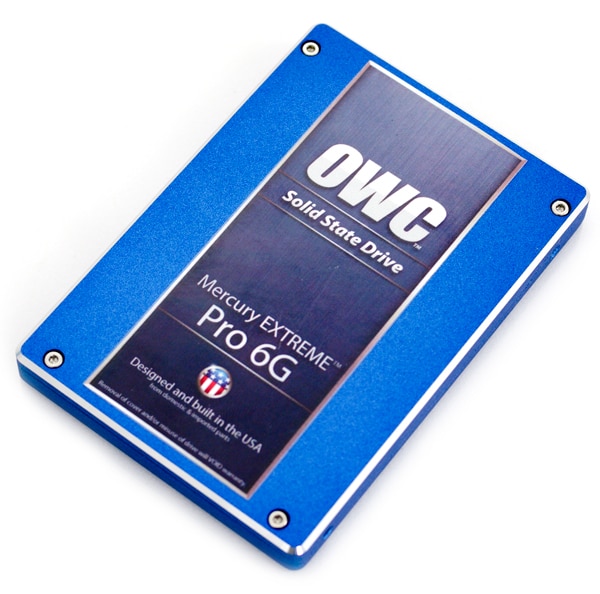
OWC Mercury Extreme Pro 6G Specs:
- Formatted Capacity – 224GB
- SandForce SF-2281 Processor
- Synchronous Tier 1/Grade A 25nm NAND Flash Storage
- SATA 6Gb/s
- Sustained Sequential Read – up to 559MB/s, Write – up to 527MB/s
- I/O Per Second (IOPS): Random 4KB – up to 60,000 IOPS
- ECC Recovery: Up to 55 bytes correctable per 512-byte sector
- Non-recoverable Read Errors: Less than 1 sector per 1016 bits read
- Chip Based Data Encryption: 256-bit & 128-bit AES-compliant
- TRIM Support
- Power Consumption: Active – <3W, Idle – <1.2W
- Warranty – 5 Years
Aesthetics
OWC stays true to their Mercury EXTREME Pro roots with the design of the new 6G SSD. The body is an all-metal design, painted metallic blue, with a machined edge circling the top of the drive. The model sticker on top of the drive has been updated from past models; now a full-gloss sticker with the OWC brand prominently displayed with the Mercury EXTREME Pro 6G name. OWC also makes sure to use the label to point out their drives are designed and built in the USA, which is pretty rare these days in the tech market.
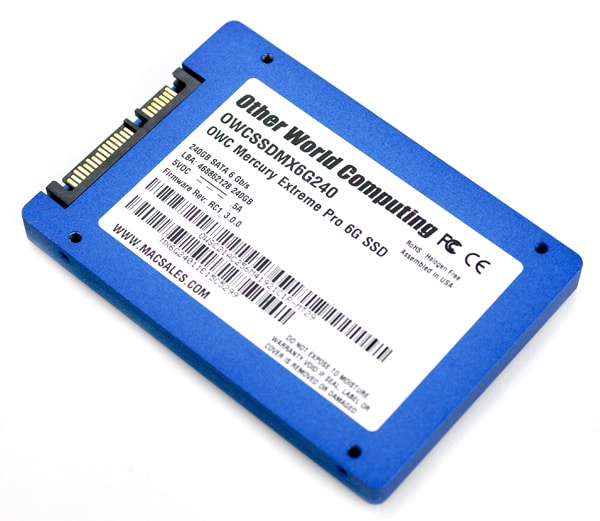
The bottom of the drive is more down to earth, with the detailed information about the drive listed, including the serial number, model number, firmware revision, and drive size specifics. The ME Pro 6G also includes lower mounting holes, which are part of the 2.5-inch drive standard.

The sides are standard, with the case seam and ground top-cover border both visible. The cut top edge looks pretty cool, reflecting light and color depending on what angle you look at the drive from.

On the front the OWC ME Pro 6G has the SATA power and data connection, with no service pins visible. Overall the look and feel of the new 6G is very impressive. Not that looks matter a great deal when it comes to selecting an SSD, but there’s something to be said for a case design that’s sturdy and visually appealing.
Disassembly
Before I go into the steps on taking apart the Mercury Extreme Pro 6G, popping the drive open will void the warranty. While our review model doesn’t have a “Warranty Void if Removed” sticker covering one of the top screw holes, I am willing to bet a sticker or two will be placed on shipping retail versions of the drive.
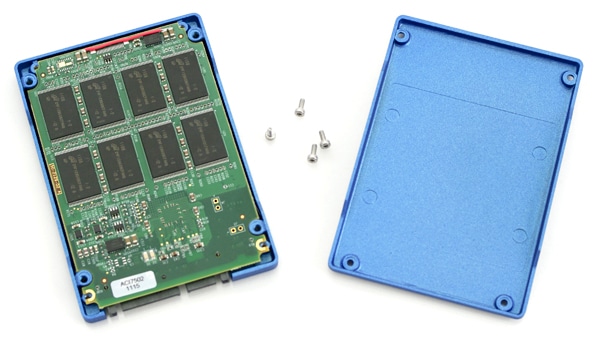
Taking the OWC ME Pro 6G apart is very simple by removing four Allen screws from the top of the drive. With the four screws removed the top cover easily lifts off, exposing the bottom of the circuit board. One interesting feature of the ME Pro 6G is a bridging wire tying four capacitors together on the back.
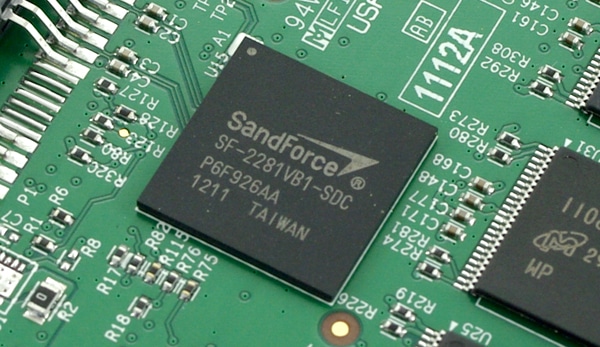
Without a doubt the main reason you might be interested in the Mercury Extreme Pro 6G is the SandForce SF-2200 family processor. Offering the fastest speeds out of any SATA 6Gb/s SSDs on the market right now, it does have a lot going for it. The ME Pro 6G uses the SF-2281VB1-SDC processor, a slightly newer variant than the one found in the pre-release OCZ Vertex 3 we reviewed.
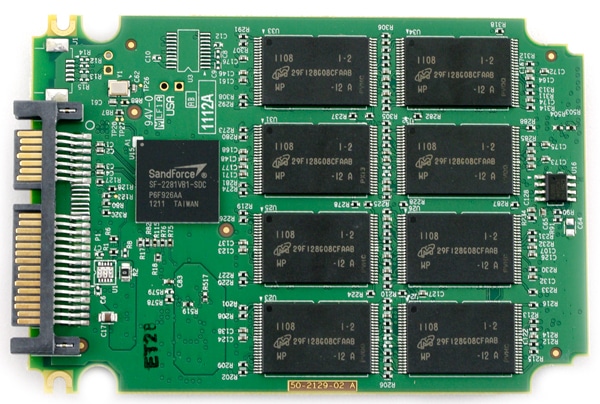
Paired up with the SandForce processor are sixteen 25nm Micron 16GB NAND 29F128G08CFAAB chips, making for a total capacity of 256GB, with 240GB available to the user after over-provisioning gets its cut.
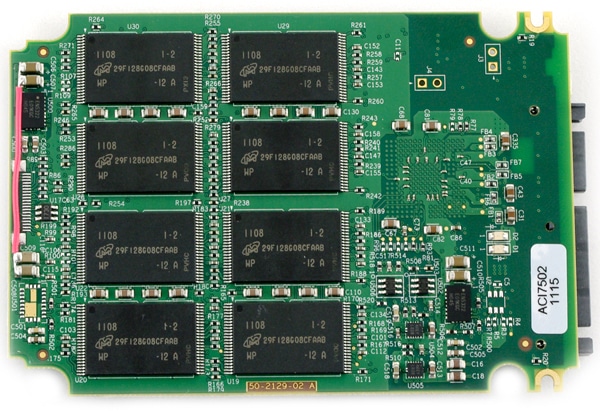
Synthetic Benchmarks
To put the OWC Mercury Extreme Pro 6G to the test, we benchmarked it on our Dell XPS 9000 with a LSI 9260-8i MegaRAID card. This combo lets us capture full SATA 3Gb/s and 6Gb/s results to see how the drive handles itself in legacy and current-generation systems.
Currently the primary competitor to the ME Pro 6G is the OCZ Vertex 3, which shares the same SandForce SF-2200 processor. The big difference outside of which NAND manufacturer OWC or OCZ goes with is how firmware is handled. To see how the Mercury Extreme Pro 6G stacks up to the Vertex 3 we start off looking at the peak sequential read and write speeds.
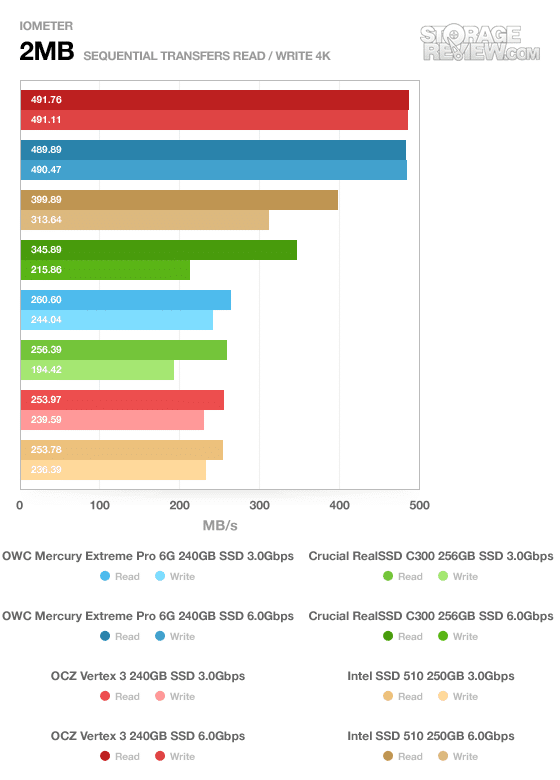
Looking at the results from IOMeter on a 2MB sequential transfer, the OWC ME Pro 6G and Vertex 3 are tied, with no significant differences between the drives. The OWC measured 489MB/s read and 490MB/s write while the OCZ squeaked out a miniscule lead with 491MB/s for both read and write.
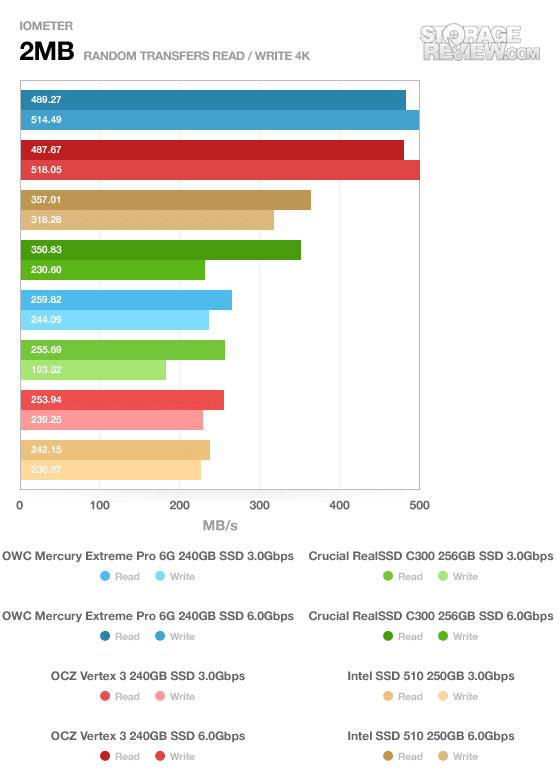
Switching from sequential to random, we look at the same transfer size in IOMeter, but closer to what real work usage might look like. In this case both drives are neck and neck again. Read speeds on both drives stayed similar to the sequential test at 489MB/s for the OWC and 487 for the OCZ, but write speeds sped up to 514MB/s on the OWC and 518MB/s on the OCZ.
The next test looks at small 4K-aligned 4K random transfers with a queue depth of 1 in IOMeter.
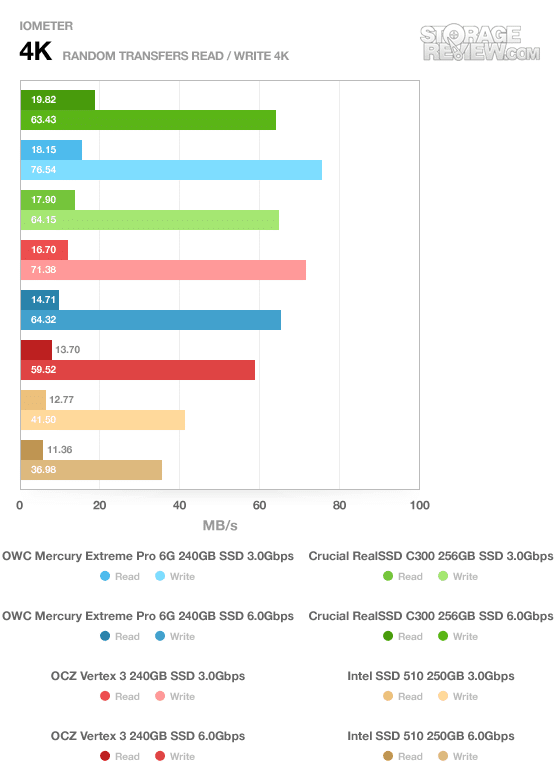
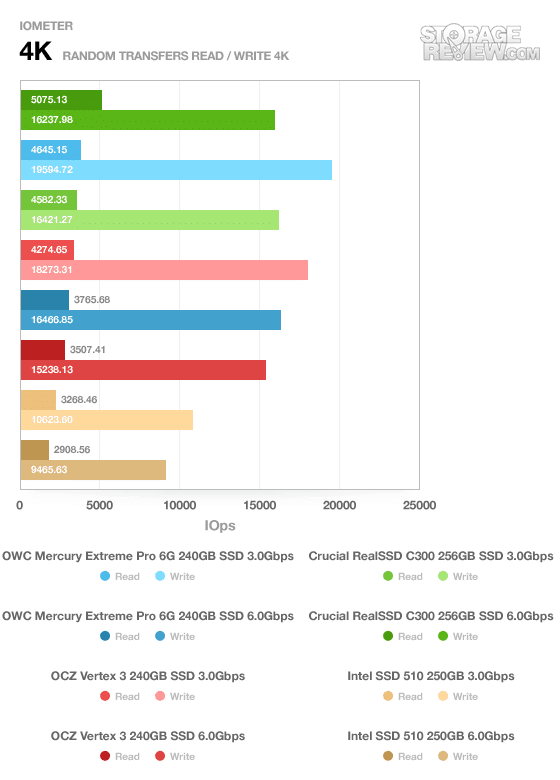
It was surprising to see the OWC Mercury Extreme Pro 6G jump ahead with a 9% lead in random 4K read speeds over a 3Gb/s interface and a 7% lead in write speeds. Over our 6Gb/s RAID card we also saw a similar trend with the OWC 6G leading the OCZ V3 slightly in random 4K writes.
For the faster drives one test we look at is ramped 4K read and write speeds over an increasing queue depth from 1 to 64.
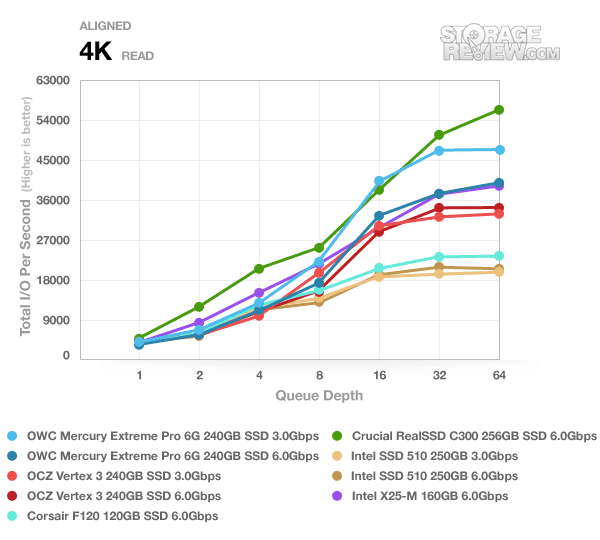
The higher 4K read and write speeds we saw above translated very well into the first random 4K read test. The OWC Mercury Extreme Pro 6G lead the Vertex 3 in both SATA 3Gb/s and 6Gb/s speeds.
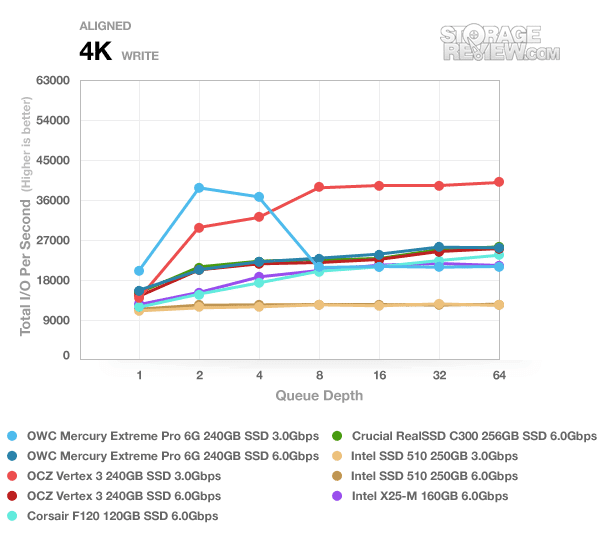
Looking at the ramped 4K write test it seems as though the higher start at the lower queue depth caused the OWC 6G to drop quicker as the test continued. This was the case even after a secure erase.
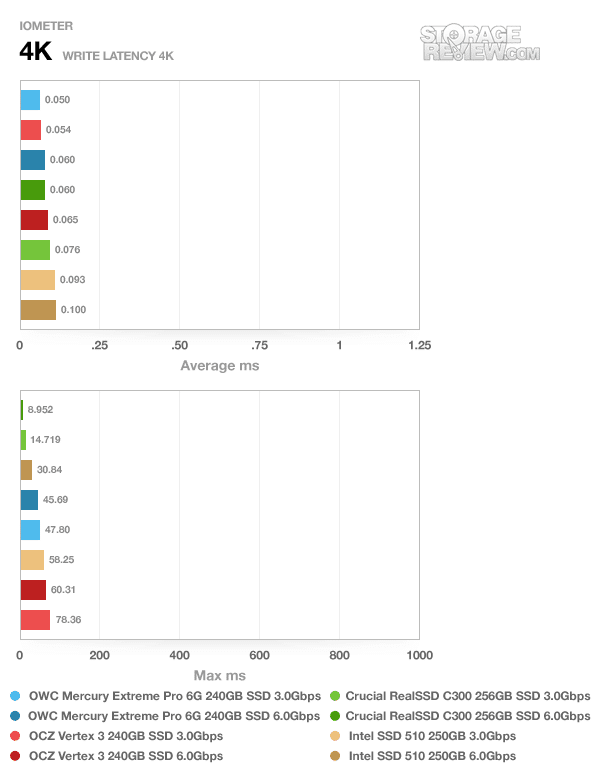
With strong random 4K write speeds, it was no surprise to see the OWC 6G leading the pack on our 4K write latency benchmark. The OWC ME Pro 6G measured 0.05ms to the OCZ V3’s 0.054ms over 3Gb/s, and 0.06ms to 0.065ms over 6Gb/s on our RAID card. The OWC 6G also maintained lower peak response times than the Vertex 3, although The Crucial C300 had them both beat with its snappy performance.
The last test we include before we go to mixed usage scenarios is CrystalDiskMark, showing speeds under conditions with fully randomized data sent to the drive. On all drives except SandForce based models, you will see very little difference in speed between sending compressible and incompressible data.
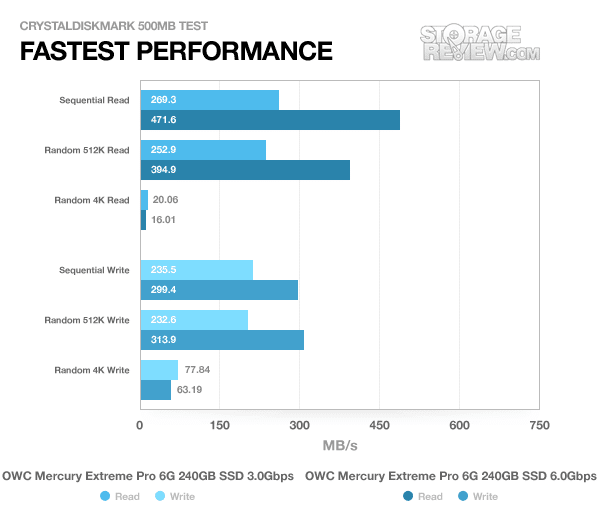
IOMeter server profile tests are very useful indicators of how drives handle multithreaded loads– similar to the ramped 4K write tests above– although with a mixed read and write profile. In all server tests the OWC ME Pro 6G either matched the Vertex 3 or every-so-slightly edged out on top of it.
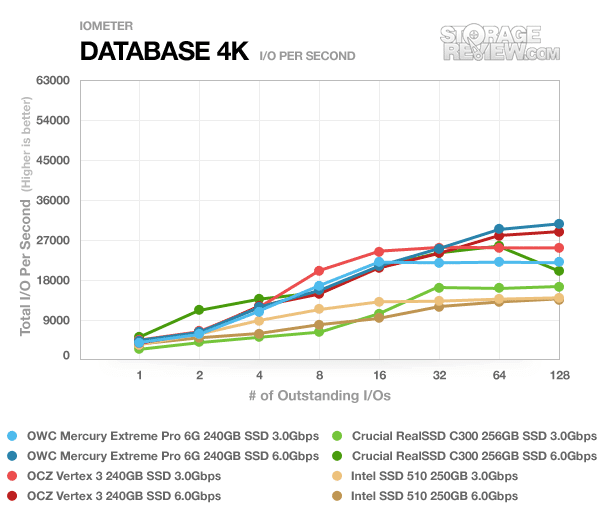
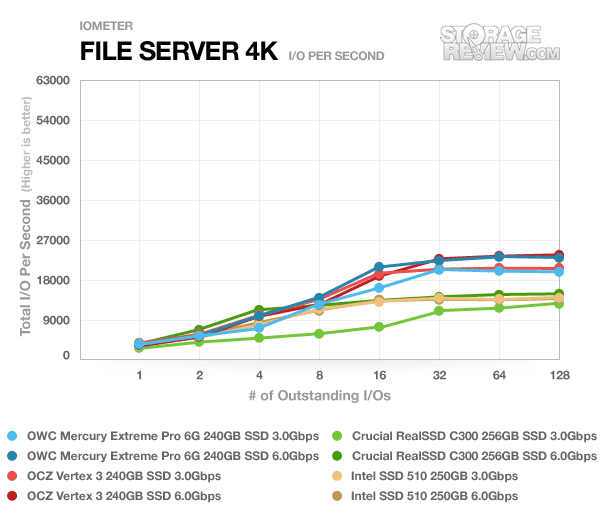
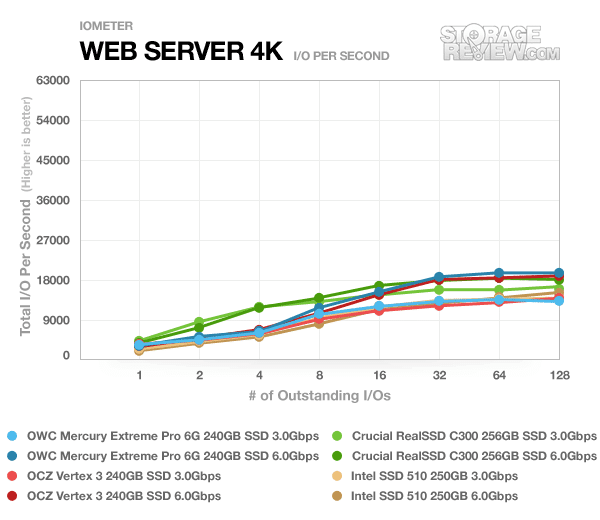
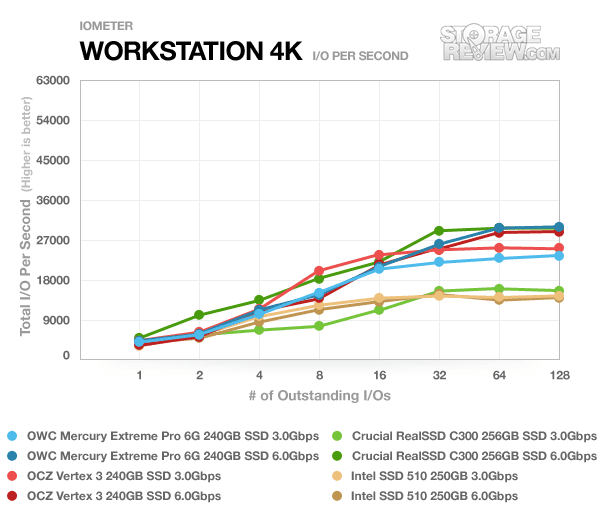
Real-World Benchmarks
If you are new to StorageReview, one thing we try to focus on is how any given drive might perform under real-world conditions. For the average user, trying to translate high random 4K write speeds into an everyday situation is pretty difficult. It also doesn’t make sense to assume that a drive with very high sequential speeds is going to perform great in the real-world if it can’t cope with mixed random activity. To really see how drives perform under normal work-loads you need to record the exact traffic being passed to and from the device, and then use that to compare drives against one another. For this reason we turned to our StorageMark 2010 traces, which include HTPC, Productivity, and Gaming scenarios to help our readers find out how well a drive might perform under their conditions.
To see how well the OWC Mercury Extreme Pro 6G held up in our real-world benchmarks, we put it up against the OCZ Vertex 3, Crucial RealSSD C300, and the Intel SSD 510. All drives were tested over a SATA 6Gb/s interface through a LSI 9260-8i MegaRAID card in single RAID0 mode, and for the SATA 3Gb/s tests the drives were connected to the Intel ICH10R in AHCI mode.
The first real-life test is our HTPC scenario. In this test we include: playing one 720P HD movie in Media Player Classic, one 480P SD movie playing in VLC, three movies downloading simultaneously through iTunes, and one 1080i HDTV stream being recorded through Windows Media Center over a 15 minute period. Higher IOps and MB/s rates with lower latency times are preferred. In this trace we recorded 2,986MB being written to the drive and 1,924MB being read.
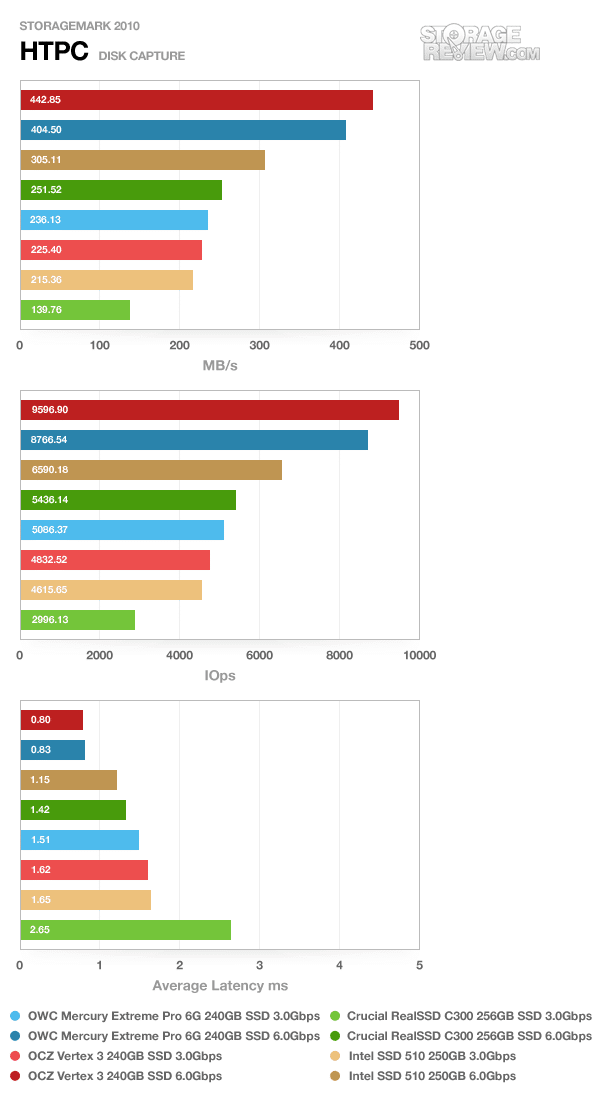
The OWC ME Pro 6G got off to a bumpy start in our HTPC trace, coming in about 38MB/s slower than the Vertex 3. It may be firmware related, since there were differences in how random 4K read and write behavior was handled compared to the Vertex 3. Even with that drop in speed, it still came in well above the Crucial C300 and Intel SSD 510 with an average speed of 404MB/s.
Our second real-life test covers disk activity in a productivity scenario. For all intents and purposes this test shows drive performance under normal daily activity for most users. This test includes: a three hour period operating in an office productivity environment with 32-bit Vista running Outlook 2007 connected to an Exchange server, web browsing using Chrome and IE8, editing files within Office 2007, viewing PDFs in Adobe Reader, and an hour of local music playback with two hours of additional online music via Pandora. In this trace we recorded 4,830MB being written to the drive and 2,758MB being read.
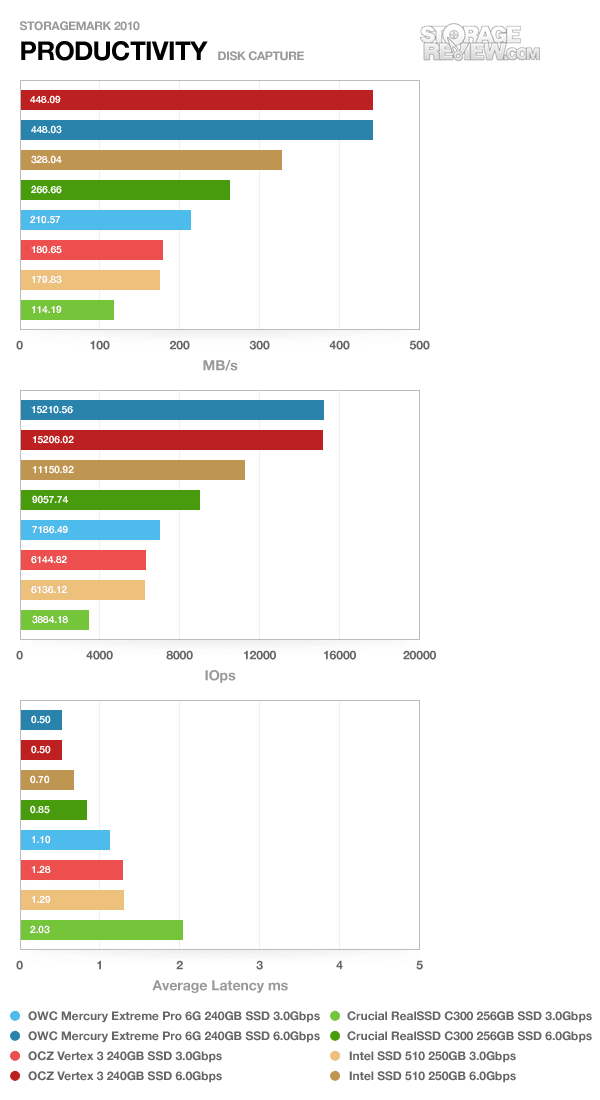
After a rocky start with the HTPC trace, the OWC 6G got back in its groove with speeds matching that of the OCZ Vertex 3. Results were so close in fact that through averaging of three benchmark runs, the OWC 6G won out in latency and IOps while the OCZ won in MB/s. Both drives far surpassed the Crucial C300 and Intel SSD 510, with speeds measuring 448MB/s.
Our third real-life test covers disk activity in a gaming environment. Unlike the HTPC or Productivity trace, this one relies heavily on the read performance of a drive. To give a simple breakdown of read/write percentages, the HTPC test is 64% write, 36% read, the Productivity test is 59% write and 41% read, while the gaming trace is 6% write and 94% read. The test consists of a Windows 7 Ultimate 64-bit system pre-configured with Steam, with Grand Theft Auto 4, Left 4 Dead 2, and Mass Effect 2 already downloaded and installed. The trace captures the heavy read activity of each game loading from the start, as well as textures as the game progresses. In this trace we recorded 426MB being written to the drive and 7,235MB being read.
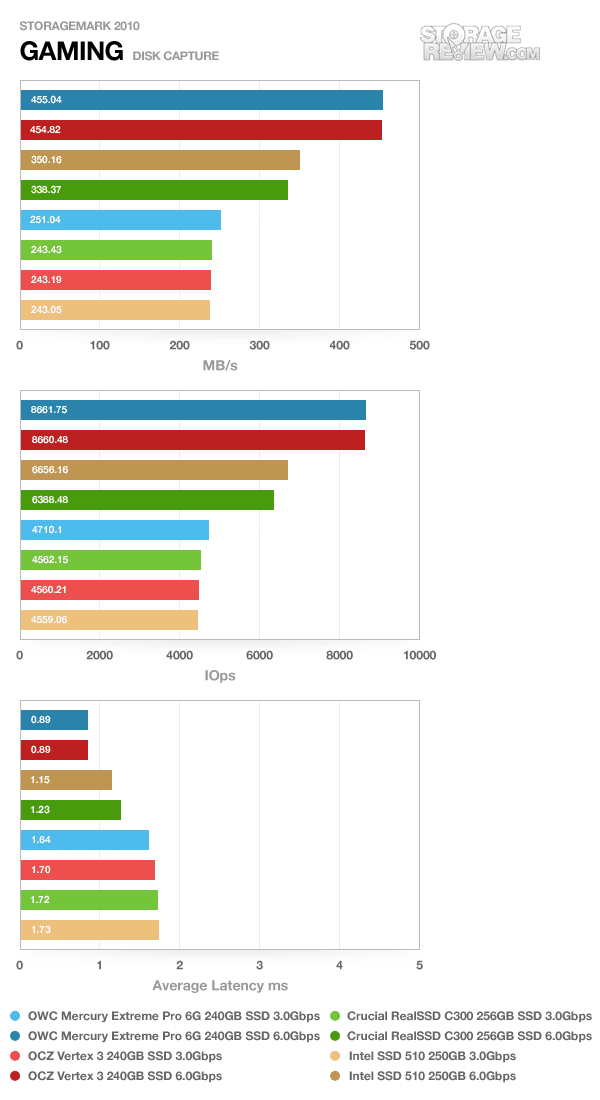
In the gaming trace we saw the OWC ME Pro 6G pick up speed to slightly to get out in front of the OCZ Vertex 3, with speeds measuring 445MB/s. The Intel SSD 510 lagged behind with just 350MB/s and the C300 with only 338MB/s.
Power Consumption
While our first look at the SandForce SF-2200 powered OCZ Vertex 3 didn’t exactly impress us with power consumption… it has thankfully been resolved on retail drives. Our first look at the pre-release Vertex 3 showed idle power rates higher than some drives under constant write activity, which was alarming at the time, but in a way we had figured optimizations would take place in the months to come. The OWC Mercury Extreme Pro 6G is the first retail-spec drive we have reviewed since then, which showed much more conservative power values.
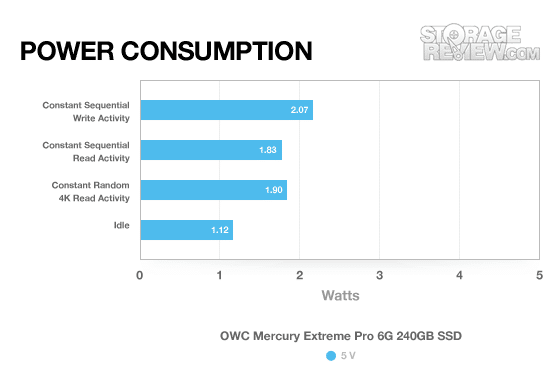
Under a constant 2MB sequential file transfer we measured 2.07 watts, which lowered to 1.83 watts in our read test. Looking at the random 4K read power values we measured 1.90 watts. The idle speed is the area that significantly improved over the early SF-2200 drive, now measuring 1.12 watts instead of nearly 2 watts previously.
Warranty
OWC backs the Mercury Extreme Pro 6G with an industry standard three year warranty. This length is matched by manufacturers such as Intel, Crucial/Micron, OCZ, and Corsair.
Update – OWC has raised their warranty for this drive
Conclusion
OWC marks the second company to come to market with a drive based around the SandForce SF-2200 processor, which as it stands seems to be the ticket to the top of our performance charts. Offering SATA 6Gb/s saturating speeds, the Mercury Extreme Pro 6G blasts the doors off other SSDs, and stays neck and neck with the OCZ Vertex 3 pretty much throughout. When compared up close to its competitor, the 6G offers stronger random 4K read and write performance at lower queue depths, although with quicker drop-offs as the queue depth increases.
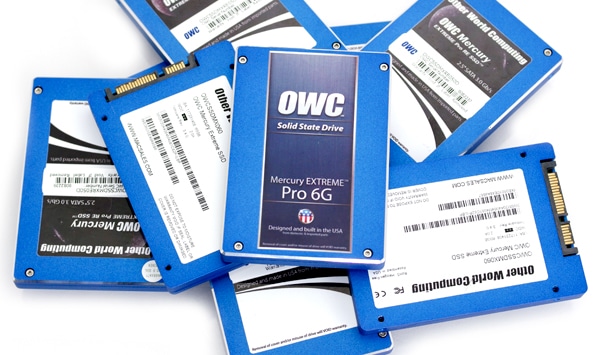
Right now OWC has itself in a very good position. With a company policy geared for reliability and consistency, they wait to release products until firmware and hardware kinks are worked out. To the end user this means less need for firmware updates since the drive is ready to go straight out of the box, and fewer bumps in the road associated with being an early adopter. OWC is also one of the few drive manufacturers that design and assemble drives in the USA, with most companies importing finished goods from overseas.
The end result is an SSD that we expect will be reliable, but we know performs like an angry beast – cranking out chart topping scores throughout our time with the drive. The Mercury Extreme Pro 6G is available in 120GB, 240GB and 480GB capacities with a suggested retail of $319, $579 and $1799 respectively. Since OWC sells their product directly, expect fewer discounts and promotions, but their pricing is generally competitive with the street pricing for the Vertex 3.
Pros
- Stronger 4K read and write speeds off the line than the Vertex 3
- Blows the doors off drives not using the SF-2200 processor
- Reliable performance right out of the box
Cons
- Lagged a bit in our HTPC trace
Bottom Line
The OWC Mercury Extreme Pro 6G offers both rock solid design and performance. The 6G regularly finds itself at the top of our charts and its engineering and firmware lead to great behavior on our test bench. Anyone looking for top-tier SATA 6Gb/s SSD performance needs to add the Mercury Extreme Pro 6G to their *very* short shopping list.
Update 8/15/11 – OWC Mercury Extreme Pro 6G SSD Review (Toggle NAND)




 Amazon
Amazon